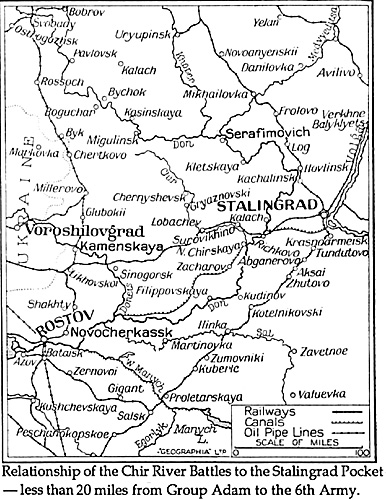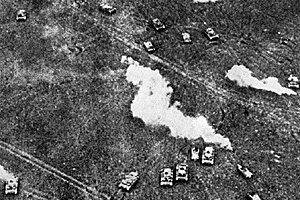 The headquarters of the 48th Panzer Corps and the divisions under its command began to arrive in the Chir salient on 4 December 1942.
The headquarters of the 48th Panzer Corps and the divisions under its command began to arrive in the Chir salient on 4 December 1942.
Relationship of the Chir River Battles to the Stalingrad Pocket - less than 20 miles from Group Adam to the 6th Army.
Manstein set the German 336th Infantry Division, commanded by Major General Walter Lucht, under the operational control of the panzer corps and this steady, veteran Saxon unit completed its deployment close to the Chir River by 6 December in the face of mounting Soviet pressure against the stopgap alarm units already in position.
Amazingly, as the German infantry division went into position,
it found a German bridgehead at Verkne Chirskaya and on ground
nearby at the confluence of the Chir and Don Rivers on the Stalingrad
side of the Chir. Colonel Adam, Colonel General Freidrich Paulus's
adjutant, had scraped together rear area troops beginning on 19
November 1942, and kept them fighting there in a truly heroic hedgehog
barely 20 miles from the closest lines of his commander's encircled
army. [20]
Lucht set the right flank of the 336th Infantry Division just north
of Nizhne Chirskaya at Lissinski on the west bank of the Chir opposite
Adam's hedgehog on the east bank. He then directed his three infantry
regiments up against the Soviet forces already across the lower reaches
of the river along an area some 25 miles to the northeast, reaching from
Nizhne Chirskaya to Nizhne Kalinovski. The Germans had to hold the
physical position on the lower Chir in order to relieve the 6th Army,
and Knobelsdorff s directions to Lucht to hold every inch of ground
included immediate local counterattacks to prevent the Soviet from
making territorial gains.
As the 336th Infantry Division completed its move into position
on 6 December 1942, elements of the 11th Panzer Division advanced
closely behind into the same area. The panzer division had the mission
to cross the Don near Nizhne Chirskaya and support
the planned relief of the Stalingrad pocket by the 4th Panzer Army
lying immediately to the south. Lieutenant General Hermann Balck,
commander of the panzer division, began to reconnoiter assembly
positions for his regiments on 7 December 1942 and found himself
immediately in a crisis as the Soviets launched a major offensive.
The Soviets attacked on 7 December 1942 in reaction to growing
strategic fears about the German forces building up with 4th Panzer
Army across the Don and south of the 48th Panzer Corps. The Soviets
recognized the German buildup as the preliminaries before a relief thrust
into the Stalingrad pocket. To secure their victory over the encircled 6th
Army, the Soviets boldly and effectively had begun to mass the
remainder of their great strategic reserve under Operation Saturn to
drive through the Italian 8th Army to the Sea of Azov and trap the
German forces in Army Group Don and Army Group A in an
optimistic attempt to end the war in 1943.
As the Germans "massed" for the relief of Stalingrad early in
December 1942, the Soviet High Command was forced to shift forces to
the Southwestern Front (partly opposite 48th Panzer Corps), the
Stalingrad Front, and Don Front to ensure the encirclement of the 6th
Army and to interfere directly with the German 48th and 57th Panzer
Corps deploying for the relief drive. The pressure that built up against
48th Panzer Corps between 4-6 December and the ensuing attack was
part of the Soviet action to maintain the encirclement of 6th Army,
while simultaneously concentrating opposite the Italian 8th Army for
the breakthrough toward Rostov.
The Soviets attacked the German force with the breakthrough 5th
Tank Army, which had been one of two operational armies that had just
encircled the 6th Army from the north. The 5th Tank Army had
advanced from Betonskaya through the Rumanian 3rd Army to Kalach
and the Chir in the period 19-23 November 1942.
[21]
The tank army had stood quietly along and just west of the Chir
from 24 November-4 December 1942, recovering from its previous
exertion and screening the Soviet lines of encirclement around Stalingrad
from the west. By 4 December 1942, the Soviet Southwestern Front,
however, had ordered it to break upthe German front on the Chir and to
interfere with any German relief attempt based on the German salient
there.
Under the unforgiving eye of impetuous, tough, Lieutenant
General N.F. Vatutin, the front commander, General Romanenko
launched the 5th Tank Army against the lower Chir hoping that, with a
moderately strong effort from part of his force, he could smash straight
through the center of the opposing lightly armed German emergency
units in position since 23 November. Romanenko made his big attack on
7 December 1942 and immediately found himself engaged with two elite
German divisions.
The battles that developed were ones between a hybrid German
panzer corps and a strong Soviet tank army. The panzer corps had a
strong panzer division, a strong horse-drawn infantry division, and,
after several days, a moderate-sized, tactically inept Luftwaffe field
division.
Figure 1 illustrates the organization and size of the German
unit and estimates the strength of the 48th Panzer Corps at
approximately 32,500 men in its divisions at the beginning on December 1942.
At the same time the 11th Panzer Division probably had a total
of approximately 75 tanks. The division of course would never employ
that number of tanks in an engagement because a significant percentage
would always be down for repair, and, as the combat developed,
manywould be destroyed or damaged in battle.
Figure 2 illustrates the organization and size of the 5th Tank
Army and estimates its strength at approximately 85,000 men in its
corps, divisions, and brigades at the beginning of December. This Soviet
tank army had at least four large formations with tanks, including an
independent tank brigade and one tank, mechanized, and guard cavalry
corps. There were probably 280 tanks available on the eve of the battles
and the Soviets fed in significant numbers of new tanks during the
fighting. [22]
Unlike the Germans, the Soviets throughout the war penny-
packeted huge numbers of tanks into regiments and brigades assigned to
infantry divisions to provide greater impetus to the infantry advance.
From 1939-1941, the Germans kept their tanks concentrated exclusively
in the panzer divisions (and short-lived light divisions of 1939). As the
Germans began to reorganize their relatively small number of motorized
rifle divisions in November 1942 into the famed panzergrenadier
divisions, they included a single panzer battalion in the new
organizations. [23]
The Germans otherwise provided few tanks, mostly captured
foreign material, to infantry formations engaged in rear area security, in
counter-partisan operations, and in a few other unusual circumstances.
German infantry divisions, accordingly, fought in the Eastern Campaign
with no tanks under their operational control, while commonly facing
Soviet infantry divisions advancing with attached, independent tank regiments and brigades.
However they were organized, the Soviet forces clearly outmatched the
Germans in numbers of men and weapons, but the style of the
opposing commanders, and particularly the sense of superiority among
the Germans, would tell heavily in the Chir battles as it had in 1941.
Arriving at the command post of the 336th Infantry Division at
Verchne Solonovski, Balck found that the Soviet 1st Tank Corps, 5th
Tank Army, was already across the Chir and had broken through the
left flank of the infantry division and thrust approximately 12 miles
west of the Chir to Sovkhoz 79 (State Farm 79).
Balck innovatively set up his command post alongside that of
Lucht and not far from the headquarters of the panzer corps. This
violation of (healthy) tactical convention paid great dividends because
the Germans reduced their reaction time to the multiple crises. The
technique also was typical of the innovative style of the self confident
German commanders. The situation on 7 December 1942 is illustrated
in detail on Map 1.
Knobelsdorff had challenging subordinate unit commanders to
direct in Balck and Lucht. The latter faced immediate operational
disaster and wanted Balck and his mobile forces to attack the Soviet 1 st
Tank Corps frontally from the southwest -the direction from which the
panzer division was arriving from Rostov. Balck refused to attack with
his armor from that direction, because, in his technical judgment as the
tank commander, that the terrain was unsuitable for the advance of
armor. Even more importantly, Balck pointed out that a frontal
attack (the Soviet tank corps had originally been heading southwest)
along a single axis would merely push the Soviets back in and amongst
the rear of the 336th Infantry Division. The Soviet lst Tank Corps had
reached a government farming complex (Sovkhoz 79), Balck decided to
destroy it there, so Knobelsdorff "simply" assigned the 11th Panzer
Division the mission of annihilating the powerful Soviet formation. The
engagement around Sovkhoz 79 set the model for the rest of the battles
on the Chir River -- Lucht coolly kept the infantry shield in position
along the river, Balck ruthlessly concentrated the entire panzer division
against the single strongest threat, and Knobelsdorff kept the missions
decisive and free of detail.
Gifted Commander: Balck
Knobelsdorff had a gifted commander in Balck. The panzer leader
had a unique quality of seeing the decisive action required at the next
higher level of command and taking that action to master crisis around
him. With or without directives and with unparalleled self-confidence,
Balck tended to unleash himself as a panzer division commander on the
panzer corps' opponent. In an interview with the author in Asperg,
West Germany, Balck described his reputation in the German army in
the following terms: "My commanders began to use the expression
when I was on the scene that 'it's just old Balck again. Let him do
whatever he wants to do.'" [24]
He went on to elaborate that when he was a battalion commander
he had somewhat retarded regimental commanders and took the actions
he felt necessary within the framework of the (to him) obviously
discernible general mission. He went on to
explain that he was driven by the same spirit of action with virtually all
of his superiors in his military career.
Curiously enough when queried by the author on how he reacted to his own subordinates operating in
the same spirit, he wagged his finger ominously and stated: "It didn't
work that way." [25]
Chir River Battles Dec 4-22 1942
 Aeriel view of battle between Germand and Soviet tanks.
Aeriel view of battle between Germand and Soviet tanks.
Introduction and Background
Immediate Preliminaries: 19 November - 4 December 1942
Chir River: 4 - 22 December 1942
Battle of Sovhkoz 79
Battle of 19 December: Kalinovski
Orders of Battle: German and Soviet
Large Maps (5): extremely slow: 494K)
Back to Table of Contents: CounterAttack # 3
To CounterAttack List of Issues
To MagWeb Master Magazine List
© Copyright 1991 by Pacific Rim Publishing Company.
This article appears in MagWeb.com (Magazine Web) on the Internet World Wide Web.
Other articles from military history and related magazines are available at http://www.magweb.com